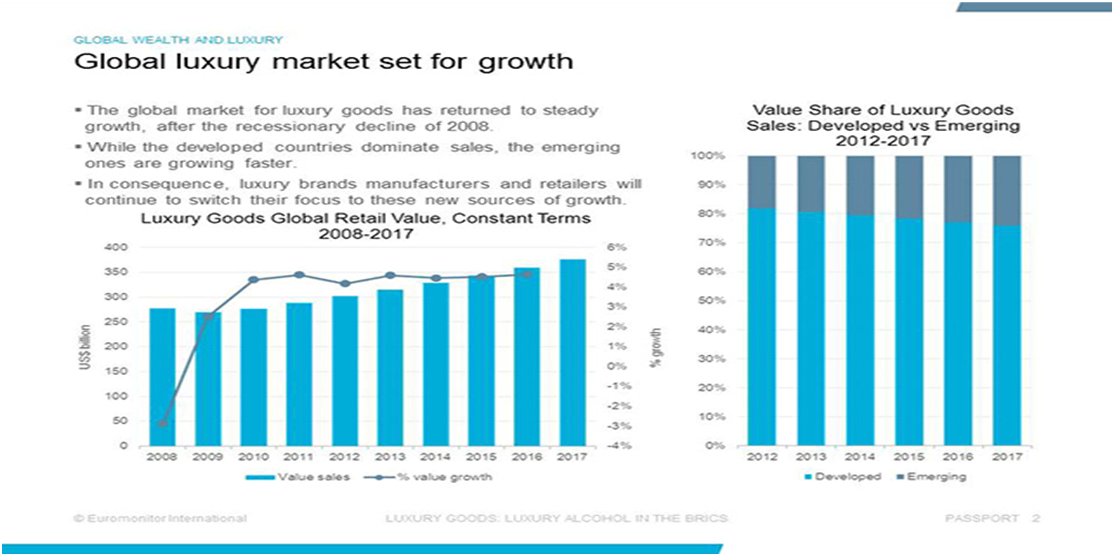Luxury Industry Analysis
The term luxury has been defined as “something inessential but conductive to pleasure and comfort” (The Free Dictionary, 2014) and “great comfort, especially as provided by expensive and beautiful things” (Cambridge Dictionaries, 2014). Accordingly, luxury industry can be defined as an industry where consumer perceived value about products and services plays greater role and the actual benefits offered by those products and services. Moreover, luxury industry is closely associated with intangible aspects of products and services.
In order to establish our luxury clothing brand, we have to make sure that there is a growing marketplace and ever growing demand for luxury clothes in the countries we wish to have our presence. According to market research analysis, there is a growing demand for luxury clothes both in the UK and worldwide. Although there is a common consensus that luxury brands suffered significant losses during and after recession, the market data discovered in this business plan proves the opposite.
The Figure 1 shows that demand and growth of the marketplace for luxury clothes have been consistently rising for the last 5-6 years. Although there is a slight shift of growth for luxury marketplace to the emerging markets such as China, overall snapshot for the luxury clothes worldwide tends to be growing at significantly fast rate of around 7-8% for the next few years.
The most obvious of these reasons is that there have been more people who have a large amount of disposable income from whom we have seen an increased desire for luxury goods. Brands that manufacture luxury goods have noticed this increase in demand, and have responded by tailoring their particular strategies to making sure that this demand is met in more areas of the world by opening stores in major cities that are entirely dedicated to the sale of these items.
In addition to an increase in consumer demand, we have also seen an overall increase in awareness by the media of this consumption, which has ultimately led to a greater amount of prevalence in culture overall. As a result of this, there are a number of academics whose research has shown that luxury brands are the most well-known and respected out of all the different strata of consumer brands.

Figure 2 Worldwide personal luxury goods market trend (Source: Bain and Co Report on Luxury Items Marketplace)
According to Figure 2 the luxury marketplace is set for a growth at around 10-11%. This research coincides with the research conducted by Euromonitor Research Group which claim that this particular marketplace is expected to grow around 8% for the next few years due to increasing disposable income and increasing customer base.
Luxury goods are generally so expensive that they cannot be afforded by anyone between the ages of 18 and 24 (Okonkwo, 2009). Once people leave that age group they tend to be able to be more likely to be able to afford these kinds of luxury goods, although they are still unlikely to be afforded by anyone until at least the age of 30. This means that people of those younger demographics never get to feel the feeling of wearing a very exclusive brand.
Similar to brands that are created for parents to purchase clothes for their kids, those brands that are targeted toward a younger age demographic, brands that are worn by students between the ages of 18 and 24 are less likely to be not able to be afforded by any other student. The brands that do exist at much higher price points, such as Banana Republic or Coach, tend to make clothes for older audiences, and do not keep up with trendy fashion (Okonkwo, 2009). In essence, there does not exist a trendy fashion store for students between the ages of 18 and 24 that exists at such a high price point that it is not unaffordable, but still creates a feeling of exclusivity by the university students that wear them (Fournier, 1989).
It would, however, be important for the brand to be well known, as this is how one creates the feeling of exclusivity (Fournier, 1989). The exclusivity of other types of luxury brands comes from the fact that they are well known by everyone, and their price is understood. The fact that the average person cannot afford to wear a certain designer is the reason that certain brands become exclusive. The fact that their price point is high is actually the first discriminatory characteristic of the goods. Because the price is so high, it immediately means that a large percentage of the population cannot afford them.
The second important piece of the puzzle for luxury goods is that their name is well known. If the name is well known, that means the price is well known, which in turns means that people will know that if you are wearing a certain brand, it is a brand that the majority of the population cannot afford (Fournier, 1989). This is what gives the brand the feeling of exclusivity, the feeling that when one person sees another person wearing a certain brand, they know that it is not a brand that people can afford.
References
Fournier, S. (1989) “Consumers and their brands: Developing relationship theory n consumer research” Journal of Consumer Research, 24, 343-373
Luxury (2014) The Free Dictionary, Available at: http://www.thefreedictionary.com/luxury
Luxury (2014) Cambridge Dictionaries, Available at: http://dictionary.cambridge.org/dictionary/british/luxury
Okonkwo, U. (2009) “The luxury brand strategy challenge” Journal of Brand Management, 16(5-6), pp. 287-289.

